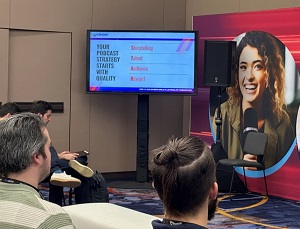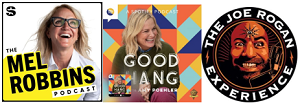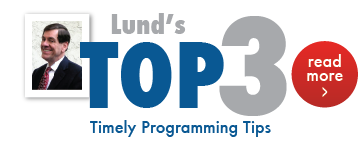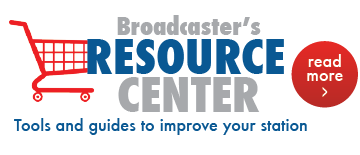Podcasting and AI were the two big topics at the April 4 NAB Show in Las Vegas. The 2025 Jacobs Media Tech Survey says Radio DJs are more popular than the songs they play.
This study highlights the enduring appeal of radio personalities, which has remained strong. The strength of personalities in traditional broadcasting and online platforms underscores their crucial role in shaping the radio experience, particularly in the face of emerging media alternatives.
 Podcasting has become a major force today.
Podcasting has become a major force today.
According to The Infinite Dial 2025, released by Edison Research in March, the percentage of 12+ Americans who have consumed a podcast has reached an all-time high.
+ 73% of Americans have consumed a podcast in either audio or video format, representing an estimated 210 million people.
+ YouTube is the service used most often to listen to podcasts, with 33% of U.S. weekly podcast listeners using it.
 + Monthly podcast listening is higher among men (57%) than women (52%).
+ Monthly podcast listening is higher among men (57%) than women (52%).
Listen to America’s three most successful podcasts; you’ll sense their huge attraction. Interviews are an important ingredient. The top three podcasts are Mel Robbins (Health & Fitness and Education), Amy Poehler (Comedy), and Joe Rogan (Comedy).
Making A Great Podcast
If you missed John Lund’s NAB workshop on talent development and podcasting, here are some highlights. Creating a great podcast is very similar to developing and executing a good radio show, without the transmitter. Here are ten tips:
1. Choose a Topic You’re Passionate About
Pick a subject that excites you, something you genuinely enjoy talking about or exploring. Passionate people naturally express enthusiasm in their voices, making the content more engaging. Plus, it helps maintain motivation long-term.
2. Create Interesting & Engaging Content
Your podcast should give listeners a reason to tune in—whether to learn something new, be entertained, or gain insight. Focus on topics that solve problems, spark curiosity, or provide a unique perspective. Include stories, real-world examples, or expert interviews to add depth and interest.
3. Study Other Successful Podcasts
Listen to other popular podcasts for ideas and inspiration. Reviewing these top podcasts in your genre is a great way to gather ideas. Pay attention to how they structure episodes, introduce topics, use music or transitions, and interact with guests or listeners. Analyzing their strengths and weaknesses will help you refine your own style and avoid common mistakes.
4. Select a Format That Fits Your Style
The format of your show sets the tone and expectations for your audience. A monologue (solo talent) is great for experts and storytellers. Interviews are ideal for learning from guests and tapping into their audiences. Co-hosted podcasts add chemistry and dialogue. The narrative and storytelling format is suited for journalism or a fictional series. Pick a format that complements your strengths and the type of content you want to share.
5. Plan Thoroughly Before You Record
Put in more time preparing than recording. Good preparation results in smoother, more focused episodes. Research your topic or guest ahead of time. Outline the flow of the episode with key points or questions. Consider scripting certain parts (like your intro, outro, or sponsor messages). The more you plan, the more professional your final product will sound.
 6. Speak Directly to One Listener
6. Speak Directly to One Listener
Speak as if you are talking to a single member of your audience. This creates a more intimate connection. It makes your podcast feel like a conversation rather than a broadcast, which increases listener engagement and loyalty.
7. Choose a Reliable Hosting Platform
Your podcast needs a place to live and be distributed. Consider hosting platforms like Buzzsprout, Podbean, Fireside, SoundCloud, or Anchor (Spotify for Podcasters). They will store your audio files, generate an RSS feed, distribute them to platforms like Apple Podcasts and Spotify, and offer analytics to track your growth.
8. Produce Consistent Content on a Regular Schedule.
Publishing consistently (weekly, biweekly, etc.) helps build an audience that knows when to expect new content. It also demonstrates commitment and professionalism. Sporadic uploads make it harder for listeners to stay engaged or recommend your show to others.
9. Consider Video or Visual Enhancements
Video podcasts (or “vodcasts”) are increasingly popular, especially on YouTube. Even short video clips from your recordings can be repurposed for TikTok, Instagram, or LinkedIn. Adding a visual element expands your reach, improves discoverability, and offers new engagement opportunities.
10. Continuously Improve
After each episode, review your listener numbers and analytics. Read reviews or listener feedback. Look for patterns, like what topics perform best and what people love. Use this info to tweak your format, improve delivery, or explore new angles.
Also, use your radio show to promote your podcast and cross-promote back to the station. Use station promos and social media to get the word out about your podcast. And invest in great audio and video quality. Stay passionate and authentic. Your enthusiasm is contagious. Be yourself—audiences crave authenticity over polish. Let your personality come through naturally. And choose topics and guests that genuinely excite you.



